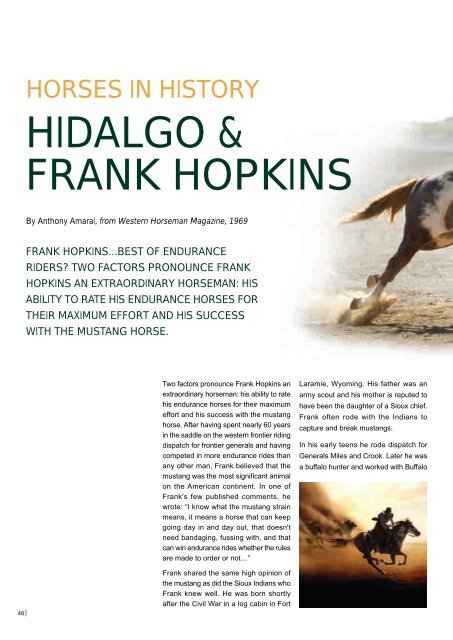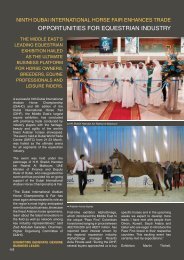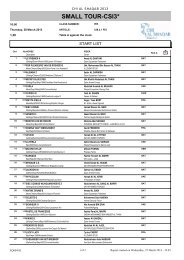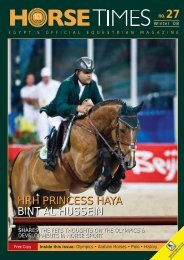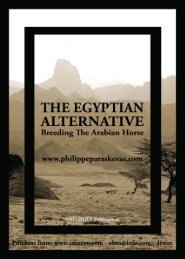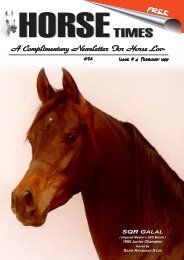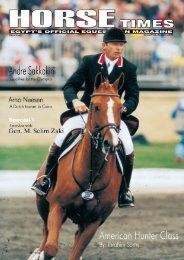HIDALGO & FRANK HOPKINS HORSES IN HISTORY ... - Horse Times
HIDALGO & FRANK HOPKINS HORSES IN HISTORY ... - Horse Times
HIDALGO & FRANK HOPKINS HORSES IN HISTORY ... - Horse Times
Create successful ePaper yourself
Turn your PDF publications into a flip-book with our unique Google optimized e-Paper software.
48<br />
<strong>HORSES</strong> <strong>IN</strong> <strong>HISTORY</strong><br />
<strong>HIDALGO</strong> &<br />
<strong>FRANK</strong> <strong>HOPK<strong>IN</strong>S</strong><br />
By Anthony Amaral, from Western <strong>Horse</strong>man Magazine, 1969<br />
<strong>FRANK</strong> <strong>HOPK<strong>IN</strong>S</strong>...BEST OF ENDURANCE<br />
RIDERS? TWO FACTORS PRONOUNCE <strong>FRANK</strong><br />
<strong>HOPK<strong>IN</strong>S</strong> AN EXTRAORD<strong>IN</strong>ARY HORSEMAN: HIS<br />
ABILITY TO RATE HIS ENDURANCE <strong>HORSES</strong> FOR<br />
THEIR MAXIMUM EFFORT AND HIS SUCCESS<br />
WITH THE MUSTANG HORSE.<br />
Two factors pronounce Frank Hopkins an<br />
extraordinary horseman: his ability to rate<br />
his endurance horses for their maximum<br />
effort and his success with the mustang<br />
horse. After having spent nearly 60 years<br />
in the saddle on the western frontier riding<br />
dispatch for frontier generals and having<br />
competed in more endurance rides than<br />
any other man, Frank believed that the<br />
mustang was the most significant animal<br />
on the American continent. In one of<br />
Frank's few published comments, he<br />
wrote: “I know what the mustang strain<br />
means, it means a horse that can keep<br />
going day in and day out, that doesn't<br />
need bandaging, fussing with, and that<br />
can win endurance rides whether the rules<br />
are made to order or not…”<br />
Frank shared the same high opinion of<br />
the mustang as did the Sioux Indians who<br />
Frank knew well. He was born shortly<br />
after the Civil War in a log cabin in Fort<br />
Laramie, Wyoming. His father was an<br />
army scout and his mother is reputed to<br />
have been the daughter of a Sioux chief.<br />
Frank often rode with the Indians to<br />
capture and break mustangs.<br />
In his early teens he rode dispatch for<br />
Generals Miles and Crook. Later he was<br />
a buffalo hunter and worked with Buffalo
Jones, Bill Matheson, William Hinrer, and<br />
Bill Cody. He was riding mustangs and<br />
had developed definite opinions about<br />
them. When Frank was riding as a<br />
messenger for General Crook, the general<br />
mentioned to Frank “...if troops can't<br />
overtake a band of Indians in 2 hours, it's<br />
better to give up the chase." Frank<br />
pursued the comment and the General<br />
replied that the wiry Indian ponies "...can<br />
go 90 miles without food or water. They<br />
can wear out all the cavalry horses we<br />
have on the frontier.”<br />
Frank probably was aware of the problem<br />
even before General Crook had realised<br />
the situation. Besides the phenomenal<br />
endurance of the mustang, Frank also<br />
rated the mustang as an intelligent and<br />
economical horse.<br />
“You can’t beat mustang intelligence in<br />
the entire equine race. These animals<br />
have had to shift for themselves for<br />
generations. They had to work out their<br />
own destiny or be destroyed. Those that<br />
survived were animals of superior<br />
intelligence. The mustang was grass-fed<br />
all his life. He picked his own food from<br />
the country, could live where even a cow<br />
would starve, and knew how to take such<br />
good care of himself that he was always<br />
ready to go.”<br />
ARTICLE BY ANTHONY AMARAL,<br />
SENT TO GILBERT JONES, FORMER<br />
PRESIDENT OF THE SPANISH<br />
MUSTANG REGISTRY, WHO THEN<br />
SUBMITTED IT TO THE EDITOR OF<br />
THE SMR NEWSLETTER <strong>IN</strong> THE<br />
1950’S:<br />
Hidalgo will never have a bronze<br />
monument erected in his memory to grace<br />
a green turf, as have Man O'War and<br />
Citation. And for some reason or other,<br />
his name and pluckiness escape the<br />
pages in books that list the "Who's Who"<br />
of the equine world.<br />
Yet, pound for pound, Hidalgo, a pinto<br />
mustang bred and raised with the Indians<br />
on a harsh South Dakota reservation, was<br />
more horse than a dozen of his blueblooded<br />
cousins put together. But the<br />
remarkable story of Hidalgo is also the<br />
account of Frank Hopkins, a westerner<br />
who had no peer when endurance riding<br />
was the rage at the turn of the century.<br />
All in all, the slender, dauntless Hopkins<br />
who developed his endurance riding ability<br />
carrying dispatch for such frontier generals<br />
as Miles and Crook, competed in 400<br />
long distance rides. If blue ribbons had<br />
been awarded to the winner at the finish<br />
line, Hopkins would have tallied 400. One<br />
of his lengthy rides started at Galveston,<br />
Texas and ended at Rutland, Vermont. A<br />
1,800-mile ride in 31 days and finished 2<br />
weeks ahead of the next rider. The<br />
greatest contest was still to come<br />
however; 3,000 miles across the Arabian<br />
desert against esteemed desert-bred<br />
Arabian horses.<br />
Hopkins had raised Hidalgo from Sioux<br />
Indian stock on the Pine Ridge<br />
Reservation in South Dakota. Like many<br />
Mustangs of that time, Hidalgo was<br />
descended from horses brought to this<br />
continent by the Spanish Conquistadors.<br />
Hopkins preferred this type of horse for<br />
his rides. They were not much for looks<br />
but their indefatigable endurance<br />
outweighed their poor appearance. In<br />
ensuing years, Hopkins teamed up with<br />
the Buffalo Bill Wild West Show as a<br />
specialty rider. While in Paris during the<br />
49
50<br />
World's Fair in 1889, Rau Rasmussen, a<br />
lover of fine horses, approached him and<br />
a businessman who dominated most of<br />
the camel freighting around Aden on the<br />
southern tip of Arabia. Rasmussen spoke<br />
to Hopkins, telling him of an endurance<br />
ride that was held in Arabia each year, as<br />
it had been for 1.000 years. Only desertbred<br />
Arabians had ever competed in the<br />
long trek. But Rasmussen had heard of<br />
the prairie mustangs, those scrubby,<br />
coarse-looking horses which had outrun<br />
the fastest horses the frontier cavalry had<br />
mustered against mounted Indians. He<br />
asked Hopkins if he would be willing to<br />
pit one of his mustangs against Arabian<br />
horses. With the financial support of the<br />
Congress of Rough Riders of the World,<br />
Hopkins' acceptance immediately stirred<br />
keen interest in cavalry and civilian horse<br />
circles throughout the world. Hopkins<br />
arrived in Arabia in 1890 for the endurance<br />
race, bringing with him 3 horses; Hidalgo,<br />
then 8 years old, was Hopkins' final choice<br />
for the ride. Slightly over 100 horses<br />
started on the ride from Aden. The great<br />
caravan of skilled Arabian riders rode their<br />
most prized mounts. They were spirited,<br />
accustomed to the difficulty of traversing<br />
the sands, and accustomed to the sun<br />
that sprayed exhausting heat upon them.<br />
Even among the mass of mounted<br />
horsemen, Hopkins stood out with particoloured,<br />
950-pound Hidalgo from the<br />
American plains. Hopkins held Hidalgo<br />
at a steady pace as they made their way<br />
through the dry heat and over sandy soil.<br />
The march progressed to the Persian Gulf<br />
and up toward Syria and then along the<br />
border of Syria and Arabia. Each day the<br />
riders started with the sun, following it<br />
until they were marching into it. <strong>Horse</strong>s<br />
dropped by the way, some exhausted,<br />
some lame. At the end of the first week,<br />
the scarcity of water and the meager diet<br />
the horses were forced to exist upon in<br />
the barren country had culled the<br />
inadequate horses.<br />
The strung line of riders dwindled daily.<br />
Entering the second week of the gruelling<br />
trek, Hopkins made his move and started<br />
to pass the other desert riders. In the<br />
Hopkins & parti-coloured Hidalgo walking the deserts of Arabia<br />
wake of the sand kicked up by Hidalgo,<br />
treasured Arabian horses of the Bedouins<br />
fell farther and farther behind, while Hidalgo<br />
kept to a steady pace.<br />
On the 66th day of the ride Hopkins rode<br />
Hidalgo to the finish stone, leaving behind<br />
him 3.000 scorching miles. Hidalgo had<br />
lost considerable weight, drawing his pinto<br />
hide close to his bones. Hopkins had him<br />
well rested and fed when the second horse<br />
arrived 33 hours later. The Arabs praised<br />
Hidalgo for the distinction he had won. He<br />
had lived up to his name “exceptional,”<br />
“exalted.”<br />
The story of Hidalgo is still mentioned<br />
among Arabian horse enthusiasts, but<br />
always with the conjecture, was Hidalgo<br />
an exceptional horse? Did he, as the<br />
typical representative of the mustangs of<br />
the American plains show superiority over<br />
the most acclaimed breed in the world,<br />
the Arabian horse? HT


